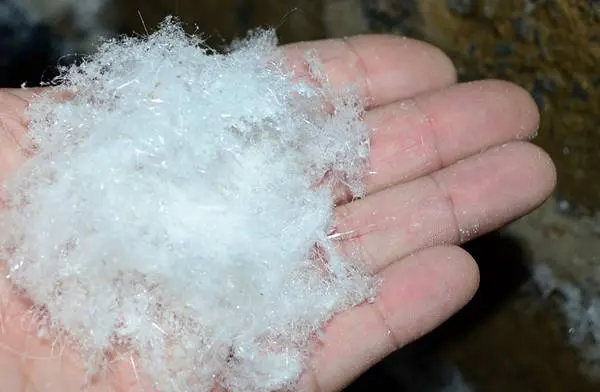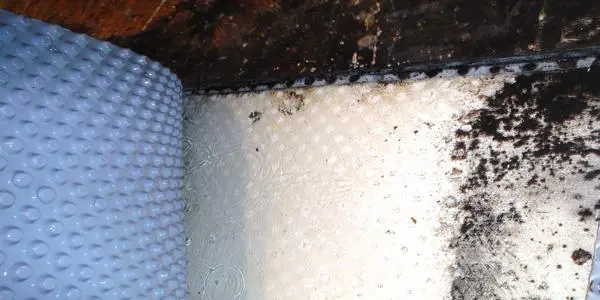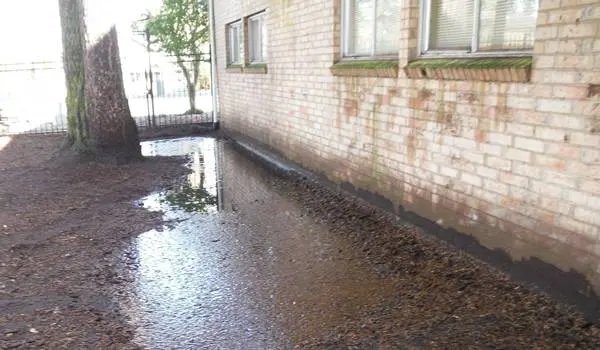
Identifying mold growth on concrete can be a bit tricky. If it’s black mold growth, it is easy to identify. But if it’s white mold growth, things can get confusing. There are several similar looking substances that can fool you.
Efflorescence can look very similar to white mold growth. It occurs when moisture moves through concrete (or other types of masonry) and pulls minerals along with the water. As the water evaporates at the surface, the salts and minerals are left behind, leaving a crystalline growth.

Mold or efflorescence? (it’s the latter)
Differentiating between mold and minerals is easy. Spray a small amount of water on the substance. If it dissolves away, it’s efflorescence. If it doesn’t, it’s likely mold growing in your basement.
Moisture. This is the one variable we can control when dealing with mold. With concrete you have 3 primary avenues for excess moisture.
If any part of your home is below grade, you’ve essentially created a giant empty bowl surrounded by water. Without proper drainage and/or a sump pump, the water will eventually make it through the concrete. Large cracks or holes are not necessary. Hydrostatic pressure is quite powerful and can force large amounts of water through hairlines cracks. Liquid water intrusions certainly can cause mold growth, however it is usually quite localized.

Mold growing on concrete beneath failed waterproofing
Concrete is a poor insulator. During the winter months when the temperature drops, the cool surface of a concrete wall can cause condensation. In time this elevated surface moisture creates an environment conducive to mold growth.
Mold growth on concrete due to humidity is typically diffuse and spread across a large area.
On it’s own, concrete does not provide a sufficient food source for fungal growth. Unfortunately this is not especially helpful, because like almost anywhere in a building, dust quickly accumulates on the surface. Within this layer of dust large quantities of food sources for mold are present. Therefore, unless the concrete is kept extremely clean, mold growth can occur.
Of course, even if the concrete is covered in dust, mold will not grow without sufficient moisture. In most situations, controlling the moisture, rather than the dust, is far more desirable. This includes tackling both airborne moisture (lowering the humidity) and liquid moisture (flooding, vapor drive).
Thankfully, because of the extreme durability of concrete, removing mold growth is a relatively simple process. Unlike sheet rock, framing or carpeting, you don’t need to worry about damaging the underlying material.
If it’s a large area, a professional should perform the remediation. They’ll setup containment and HEPA filtration to ensure the spores don’t spread throughout your home during the cleanup process. If the area is relatively small, you can likely tackle it yourself.
The removal process typically requires the use of both a fungicide and physical removal of the mold. The fungicide will deactivate and kill the mold spores, but staining and discoloration will likely remain. This is often addressed with HEPA vacuuming, scrubbing, steam cleaning, sandblasting, etc. In large commercial settings, dry ice blasting is occasionally used to remove mold from concrete.
A note about expectations
While cleaning the active growth from the concrete is relatively straightforward, some staining will often remain. This is especially true when dealing with black mold growth. The pigment left behind by the growth can be difficult to remove. It’s important to remember, this staining is not a health hazard, nor can it regrow. It’s simply a byproduct of the original growth. If the discoloration remains after the initial cleaning, paint the concrete with a stain blocking concrete primer.
If at all possible, resolve the moisture issue before it hits your concrete wall. This may be as simple as redirecting downspouts away from the affected area or sloping the ground away from the wall. It’s cheap and certainly worth a try.

This is not helping their basement concrete mold issues…
If those techniques don’t solve the problem, you’re left with two choices – a french drain or interior footing drain. French drains are a great choice during the initial construction of the home or shortly thereafter. There’s little additional excavation because the foundation wall is already exposed.
Once a house is up and running, it’s a very different story. The excavation must deal with plants, trees, driveways, decks – basically anything within a few feet of the perimeter of your home. If it’s a single, unobstructed wall, it can be accomplished. But in many cases it’s cost prohibitive.
For existing homes, an interior footing drain is best. It’s the same concept of a french drain, but it’s installed inside the home, at the base of the concrete wall. In most cases, any framing directly against the wall must be removed first. If moisture is entering higher up the wall, dimple board will be necessary. This is a plastic membrane that directs the water downward toward the footing drain.
In general, sealants and coatings are ineffective against basement water intrusion issues. If you have substantial water pressure from the outside, it will find a way in your home. They can be successful in scenarios where you have a single leak from an obvious crack.
Lower the relative humidity. Concrete is a poor insulator and therefore can become quite cool during the winter months. In a poorly ventilated basement, this can cause airborne moisture to condense on the surface and cause mold growth. There are three ways to reduce the RH in the area.
This project is a perfect example of the compounding factors of poor ventilation and uninsulated concrete walls. The RH in the basement was 80%. This is very high. Mold will begin growing on random contents at this level.
80% RH is problematic even in well insulated walls. In a room with concrete walls, it’s guaranteed to cause mold growth.
Increase ventilation by installing a constant flow exhaust fan in the bathroom. These units replace a regular bath fan, but operate 24/7 at a reduced speed. They provide continuous ventilation throughout the day.